Case Study Based Nursing Assignment
VerifiedAdded on 2022/08/21
|11
|3185
|12
AI Summary
Contribute Materials
Your contribution can guide someone’s learning journey. Share your
documents today.
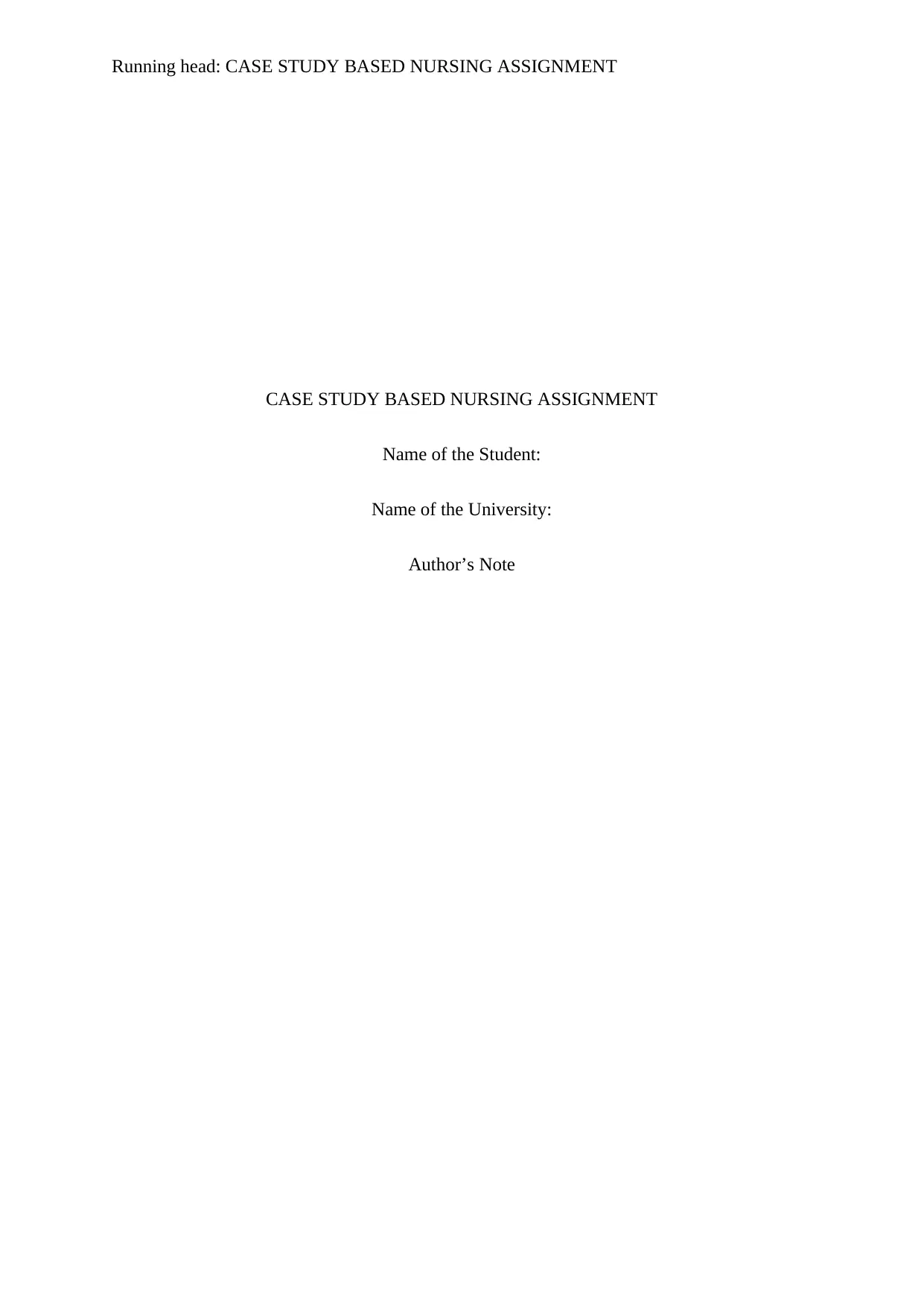
Running head: CASE STUDY BASED NURSING ASSIGNMENT
CASE STUDY BASED NURSING ASSIGNMENT
Name of the Student:
Name of the University:
Author’s Note
CASE STUDY BASED NURSING ASSIGNMENT
Name of the Student:
Name of the University:
Author’s Note
Secure Best Marks with AI Grader
Need help grading? Try our AI Grader for instant feedback on your assignments.

Running head: CASE STUDY BASED NURSING ASSIGNMENT
Answer 1: Concept Map
Figure 1: Concept Map of the given case study
Source: (Gosmanov, Gosmanova & Kitabchi, 2018)
Answer 1: Concept Map
Figure 1: Concept Map of the given case study
Source: (Gosmanov, Gosmanova & Kitabchi, 2018)

Running head: CASE STUDY BASED NURSING ASSIGNMENT
Question 2: Essay:
Diabetic ketoacidosis (DKA) is a terminal disorder that affects people who have
diabetes. The condition that initiates the process of acidosis within an individual with
diabetes is when the body starts to break down the fats at a much higher rate. The liver is the
organ responsible for the ketone of fat into a compound known as ketones. Ogawa and
Sakaguchi (2016) opined that the ketone would make the blood acidic in nature, causing a
multitude of issues in the patients. The essay aims to highlight the case study of Carly’s, a 12
years old girl who was admitted to the emergency department. She was admitted to the
hospital because of drastic weight loss in a short period and there was a history of polydipsia,
polyuria and febrile illness for two weeks. In recent times, she has developed nausea,
abdominal pain, and vomiting tendency. Various signs and symptoms were indicating the
condition to be DKA. The explanation of the pathophysiology related to each of the signs and
symptoms, as well as the test conducted upon Carly, will be assessed in gaining in-depth
knowledge of the disorder as well as the neurological deficit found in the case study will be
reviewed.
One of the important factors that need to be understood in having an in-depth
knowledge of disease is pathophysiology. Pathophysiology is disordered physiological
processes that are associated with a particular injury or disorder. Thus, it is an abnormal state
of a specific disorder or functional changes occurring in the body due to a disorder or its
syndrome. According to Farsani et al. (2017), DKA is stated to be associated with insulin
deficiency and the elevated level of blood glucose that is thought to be over 300 mg/dL.
Because of the fact, the tissue within the body, including muscle, fat and the liver, cannot use
the glucose or take up for their activities. Even though the blood has an elevated amount of
glucose, however, the cells starve due to the absence of insulin in the body. This is because
Question 2: Essay:
Diabetic ketoacidosis (DKA) is a terminal disorder that affects people who have
diabetes. The condition that initiates the process of acidosis within an individual with
diabetes is when the body starts to break down the fats at a much higher rate. The liver is the
organ responsible for the ketone of fat into a compound known as ketones. Ogawa and
Sakaguchi (2016) opined that the ketone would make the blood acidic in nature, causing a
multitude of issues in the patients. The essay aims to highlight the case study of Carly’s, a 12
years old girl who was admitted to the emergency department. She was admitted to the
hospital because of drastic weight loss in a short period and there was a history of polydipsia,
polyuria and febrile illness for two weeks. In recent times, she has developed nausea,
abdominal pain, and vomiting tendency. Various signs and symptoms were indicating the
condition to be DKA. The explanation of the pathophysiology related to each of the signs and
symptoms, as well as the test conducted upon Carly, will be assessed in gaining in-depth
knowledge of the disorder as well as the neurological deficit found in the case study will be
reviewed.
One of the important factors that need to be understood in having an in-depth
knowledge of disease is pathophysiology. Pathophysiology is disordered physiological
processes that are associated with a particular injury or disorder. Thus, it is an abnormal state
of a specific disorder or functional changes occurring in the body due to a disorder or its
syndrome. According to Farsani et al. (2017), DKA is stated to be associated with insulin
deficiency and the elevated level of blood glucose that is thought to be over 300 mg/dL.
Because of the fact, the tissue within the body, including muscle, fat and the liver, cannot use
the glucose or take up for their activities. Even though the blood has an elevated amount of
glucose, however, the cells starve due to the absence of insulin in the body. This is because

1CASE STUDY BASED NURSING ASSIGNMENT
the brain-blood barrier does not require insulin for the diffusion of glucose across the blood
as a result of which the brain cells have an optimum level of glucose in them. Therefore, the
patient experienced several signs and symptoms that indicate hyperglycemia (Jia, Whaley-
Connell & Sowers, 2018). The blood glucose level of Carly indicated that she had diabetes
where the blood sugar level was extremely high as the normal range is 3.9 to 7.1 mmol/L.
From the study of Kocher et al. (2018), it can be stated that there are several complications
related to this condition, such as increase chance of cardiovascular diseases, damage to
kidney, nerve and even the blood vessel in the retina that can potentially cause blindness. In
case of a persistent period of such level of blood glucose level in the body that was observed
in this case study, it had led to a condition known as diabetic ketoacidosis where relative no
insulin is present in the body. In addition to this, another emergency complication that occurs
is the hyperglycaemic hyperosmolar rate where insulin is produced within the body; however,
the utilisation does not occur. The low concentration of sodium states that hypernatremia and
high level of potassium state hyperkalaemia, which are both severe in nature that can lead to
heart, a disorder in patients. The pathophysiological syndromes that are associated with the
elevated level of blood glucose in DKA are metabolic acidosis, electrolyte disturbance and
osmotic diuresis. Umpierrez (2019) opined that electrolyte disturbance involves an
abnormality in the concentration of the electrolytes in the human body. The ions are found to
play a vital role in the maintenance of homeostasis and help in the regulation of the
neurological and heart function, oxygen delivery, fluid balance, and acid-base balance in the
body. The function of the kidney is affected due to such imbalance and leads to inappropriate
urination (Jayashree, Williams & Iyer, 2019). An electrolyte test was conducted in order to
measure the sodium and potassium levels in the body, which is necessary for confirming the
disorder. From the test result, it was found that the sodium level in the serum was 128
mmol/L, and potassium level was 6.3 mmol/L. As per the information, the normal blood
the brain-blood barrier does not require insulin for the diffusion of glucose across the blood
as a result of which the brain cells have an optimum level of glucose in them. Therefore, the
patient experienced several signs and symptoms that indicate hyperglycemia (Jia, Whaley-
Connell & Sowers, 2018). The blood glucose level of Carly indicated that she had diabetes
where the blood sugar level was extremely high as the normal range is 3.9 to 7.1 mmol/L.
From the study of Kocher et al. (2018), it can be stated that there are several complications
related to this condition, such as increase chance of cardiovascular diseases, damage to
kidney, nerve and even the blood vessel in the retina that can potentially cause blindness. In
case of a persistent period of such level of blood glucose level in the body that was observed
in this case study, it had led to a condition known as diabetic ketoacidosis where relative no
insulin is present in the body. In addition to this, another emergency complication that occurs
is the hyperglycaemic hyperosmolar rate where insulin is produced within the body; however,
the utilisation does not occur. The low concentration of sodium states that hypernatremia and
high level of potassium state hyperkalaemia, which are both severe in nature that can lead to
heart, a disorder in patients. The pathophysiological syndromes that are associated with the
elevated level of blood glucose in DKA are metabolic acidosis, electrolyte disturbance and
osmotic diuresis. Umpierrez (2019) opined that electrolyte disturbance involves an
abnormality in the concentration of the electrolytes in the human body. The ions are found to
play a vital role in the maintenance of homeostasis and help in the regulation of the
neurological and heart function, oxygen delivery, fluid balance, and acid-base balance in the
body. The function of the kidney is affected due to such imbalance and leads to inappropriate
urination (Jayashree, Williams & Iyer, 2019). An electrolyte test was conducted in order to
measure the sodium and potassium levels in the body, which is necessary for confirming the
disorder. From the test result, it was found that the sodium level in the serum was 128
mmol/L, and potassium level was 6.3 mmol/L. As per the information, the normal blood
Secure Best Marks with AI Grader
Need help grading? Try our AI Grader for instant feedback on your assignments.
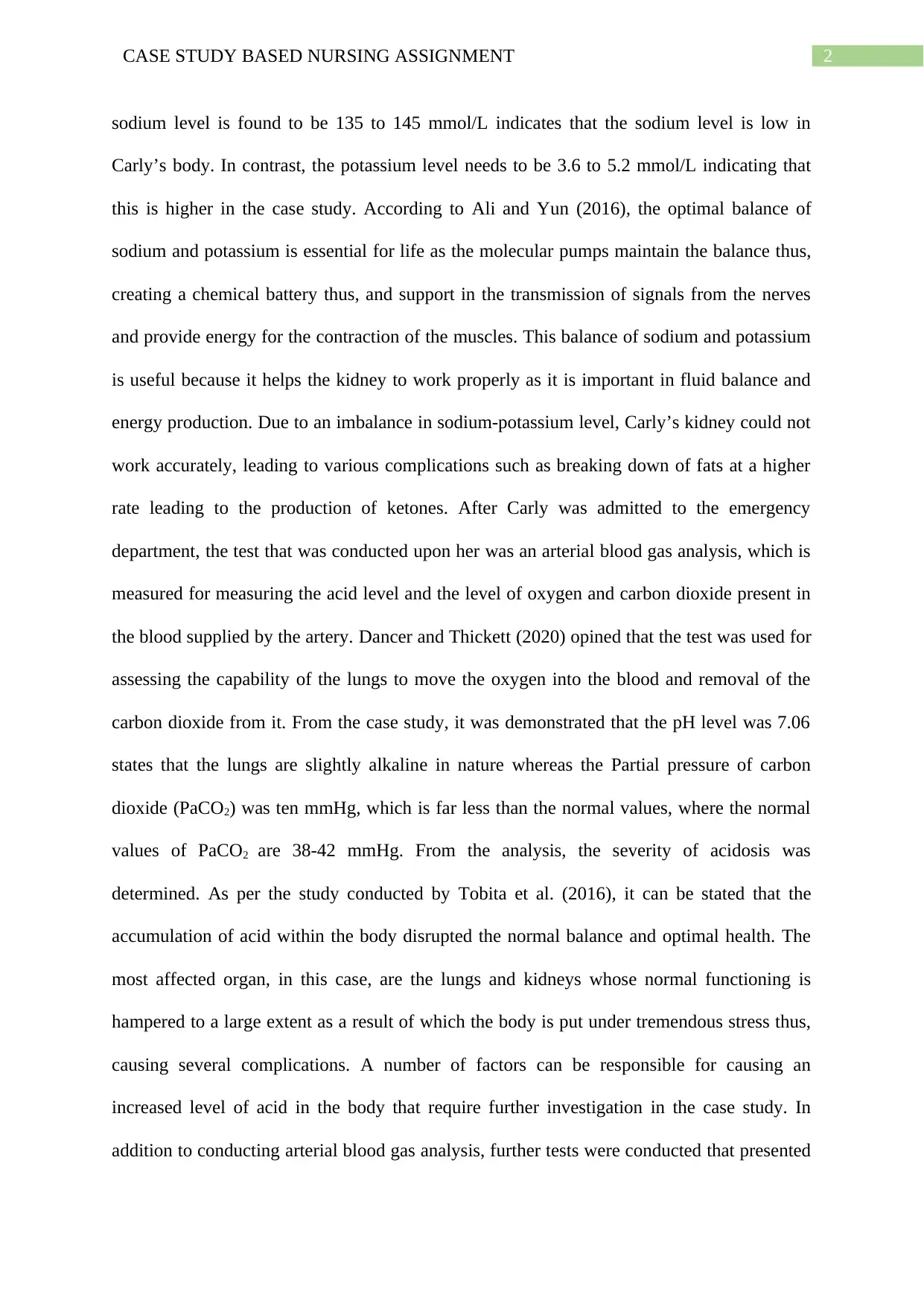
2CASE STUDY BASED NURSING ASSIGNMENT
sodium level is found to be 135 to 145 mmol/L indicates that the sodium level is low in
Carly’s body. In contrast, the potassium level needs to be 3.6 to 5.2 mmol/L indicating that
this is higher in the case study. According to Ali and Yun (2016), the optimal balance of
sodium and potassium is essential for life as the molecular pumps maintain the balance thus,
creating a chemical battery thus, and support in the transmission of signals from the nerves
and provide energy for the contraction of the muscles. This balance of sodium and potassium
is useful because it helps the kidney to work properly as it is important in fluid balance and
energy production. Due to an imbalance in sodium-potassium level, Carly’s kidney could not
work accurately, leading to various complications such as breaking down of fats at a higher
rate leading to the production of ketones. After Carly was admitted to the emergency
department, the test that was conducted upon her was an arterial blood gas analysis, which is
measured for measuring the acid level and the level of oxygen and carbon dioxide present in
the blood supplied by the artery. Dancer and Thickett (2020) opined that the test was used for
assessing the capability of the lungs to move the oxygen into the blood and removal of the
carbon dioxide from it. From the case study, it was demonstrated that the pH level was 7.06
states that the lungs are slightly alkaline in nature whereas the Partial pressure of carbon
dioxide (PaCO2) was ten mmHg, which is far less than the normal values, where the normal
values of PaCO2 are 38-42 mmHg. From the analysis, the severity of acidosis was
determined. As per the study conducted by Tobita et al. (2016), it can be stated that the
accumulation of acid within the body disrupted the normal balance and optimal health. The
most affected organ, in this case, are the lungs and kidneys whose normal functioning is
hampered to a large extent as a result of which the body is put under tremendous stress thus,
causing several complications. A number of factors can be responsible for causing an
increased level of acid in the body that require further investigation in the case study. In
addition to conducting arterial blood gas analysis, further tests were conducted that presented
sodium level is found to be 135 to 145 mmol/L indicates that the sodium level is low in
Carly’s body. In contrast, the potassium level needs to be 3.6 to 5.2 mmol/L indicating that
this is higher in the case study. According to Ali and Yun (2016), the optimal balance of
sodium and potassium is essential for life as the molecular pumps maintain the balance thus,
creating a chemical battery thus, and support in the transmission of signals from the nerves
and provide energy for the contraction of the muscles. This balance of sodium and potassium
is useful because it helps the kidney to work properly as it is important in fluid balance and
energy production. Due to an imbalance in sodium-potassium level, Carly’s kidney could not
work accurately, leading to various complications such as breaking down of fats at a higher
rate leading to the production of ketones. After Carly was admitted to the emergency
department, the test that was conducted upon her was an arterial blood gas analysis, which is
measured for measuring the acid level and the level of oxygen and carbon dioxide present in
the blood supplied by the artery. Dancer and Thickett (2020) opined that the test was used for
assessing the capability of the lungs to move the oxygen into the blood and removal of the
carbon dioxide from it. From the case study, it was demonstrated that the pH level was 7.06
states that the lungs are slightly alkaline in nature whereas the Partial pressure of carbon
dioxide (PaCO2) was ten mmHg, which is far less than the normal values, where the normal
values of PaCO2 are 38-42 mmHg. From the analysis, the severity of acidosis was
determined. As per the study conducted by Tobita et al. (2016), it can be stated that the
accumulation of acid within the body disrupted the normal balance and optimal health. The
most affected organ, in this case, are the lungs and kidneys whose normal functioning is
hampered to a large extent as a result of which the body is put under tremendous stress thus,
causing several complications. A number of factors can be responsible for causing an
increased level of acid in the body that require further investigation in the case study. In
addition to conducting arterial blood gas analysis, further tests were conducted that presented
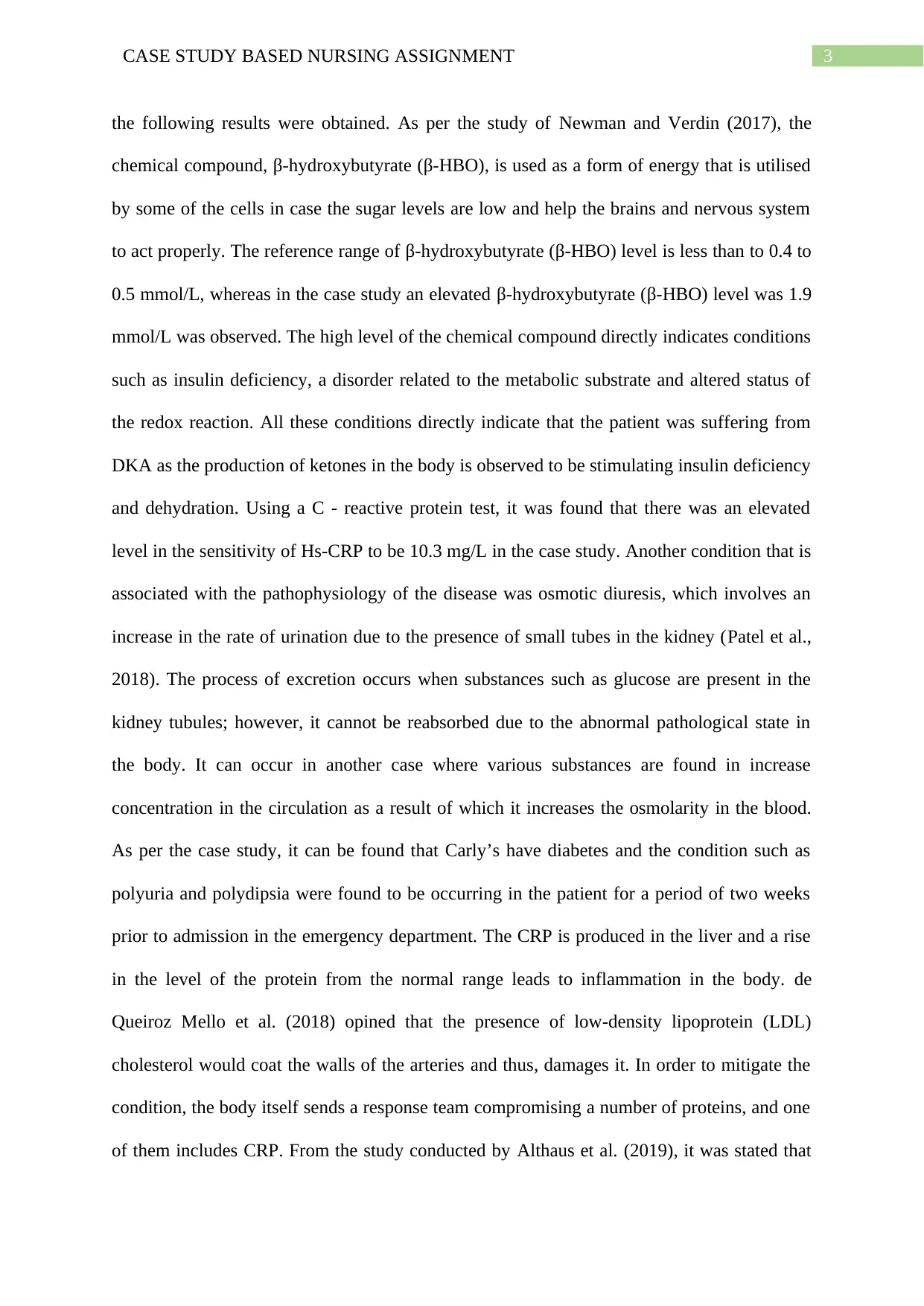
3CASE STUDY BASED NURSING ASSIGNMENT
the following results were obtained. As per the study of Newman and Verdin (2017), the
chemical compound, β-hydroxybutyrate (β-HBO), is used as a form of energy that is utilised
by some of the cells in case the sugar levels are low and help the brains and nervous system
to act properly. The reference range of β-hydroxybutyrate (β-HBO) level is less than to 0.4 to
0.5 mmol/L, whereas in the case study an elevated β-hydroxybutyrate (β-HBO) level was 1.9
mmol/L was observed. The high level of the chemical compound directly indicates conditions
such as insulin deficiency, a disorder related to the metabolic substrate and altered status of
the redox reaction. All these conditions directly indicate that the patient was suffering from
DKA as the production of ketones in the body is observed to be stimulating insulin deficiency
and dehydration. Using a C - reactive protein test, it was found that there was an elevated
level in the sensitivity of Hs-CRP to be 10.3 mg/L in the case study. Another condition that is
associated with the pathophysiology of the disease was osmotic diuresis, which involves an
increase in the rate of urination due to the presence of small tubes in the kidney (Patel et al.,
2018). The process of excretion occurs when substances such as glucose are present in the
kidney tubules; however, it cannot be reabsorbed due to the abnormal pathological state in
the body. It can occur in another case where various substances are found in increase
concentration in the circulation as a result of which it increases the osmolarity in the blood.
As per the case study, it can be found that Carly’s have diabetes and the condition such as
polyuria and polydipsia were found to be occurring in the patient for a period of two weeks
prior to admission in the emergency department. The CRP is produced in the liver and a rise
in the level of the protein from the normal range leads to inflammation in the body. de
Queiroz Mello et al. (2018) opined that the presence of low-density lipoprotein (LDL)
cholesterol would coat the walls of the arteries and thus, damages it. In order to mitigate the
condition, the body itself sends a response team compromising a number of proteins, and one
of them includes CRP. From the study conducted by Althaus et al. (2019), it was stated that
the following results were obtained. As per the study of Newman and Verdin (2017), the
chemical compound, β-hydroxybutyrate (β-HBO), is used as a form of energy that is utilised
by some of the cells in case the sugar levels are low and help the brains and nervous system
to act properly. The reference range of β-hydroxybutyrate (β-HBO) level is less than to 0.4 to
0.5 mmol/L, whereas in the case study an elevated β-hydroxybutyrate (β-HBO) level was 1.9
mmol/L was observed. The high level of the chemical compound directly indicates conditions
such as insulin deficiency, a disorder related to the metabolic substrate and altered status of
the redox reaction. All these conditions directly indicate that the patient was suffering from
DKA as the production of ketones in the body is observed to be stimulating insulin deficiency
and dehydration. Using a C - reactive protein test, it was found that there was an elevated
level in the sensitivity of Hs-CRP to be 10.3 mg/L in the case study. Another condition that is
associated with the pathophysiology of the disease was osmotic diuresis, which involves an
increase in the rate of urination due to the presence of small tubes in the kidney (Patel et al.,
2018). The process of excretion occurs when substances such as glucose are present in the
kidney tubules; however, it cannot be reabsorbed due to the abnormal pathological state in
the body. It can occur in another case where various substances are found in increase
concentration in the circulation as a result of which it increases the osmolarity in the blood.
As per the case study, it can be found that Carly’s have diabetes and the condition such as
polyuria and polydipsia were found to be occurring in the patient for a period of two weeks
prior to admission in the emergency department. The CRP is produced in the liver and a rise
in the level of the protein from the normal range leads to inflammation in the body. de
Queiroz Mello et al. (2018) opined that the presence of low-density lipoprotein (LDL)
cholesterol would coat the walls of the arteries and thus, damages it. In order to mitigate the
condition, the body itself sends a response team compromising a number of proteins, and one
of them includes CRP. From the study conducted by Althaus et al. (2019), it was stated that
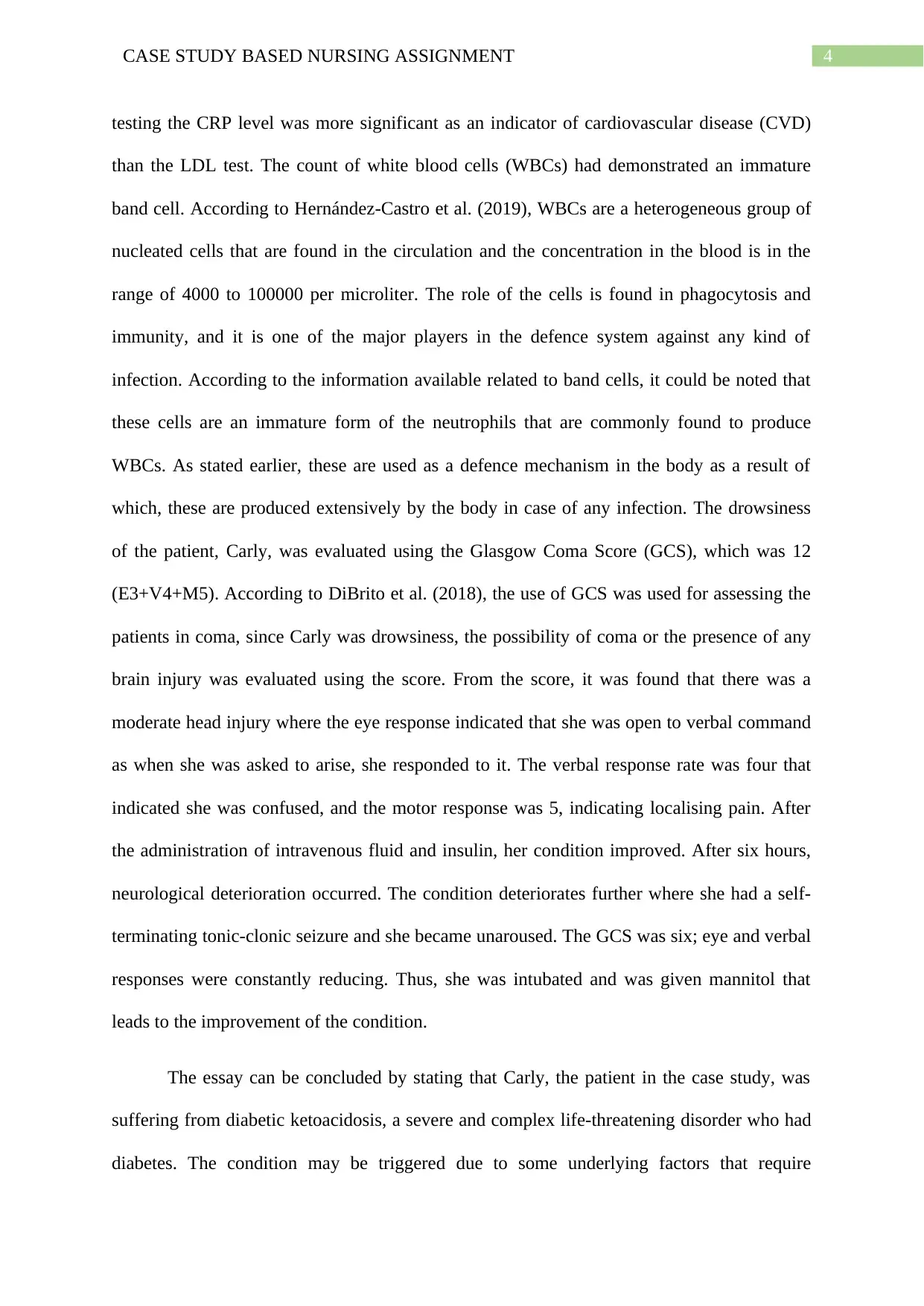
4CASE STUDY BASED NURSING ASSIGNMENT
testing the CRP level was more significant as an indicator of cardiovascular disease (CVD)
than the LDL test. The count of white blood cells (WBCs) had demonstrated an immature
band cell. According to Hernández-Castro et al. (2019), WBCs are a heterogeneous group of
nucleated cells that are found in the circulation and the concentration in the blood is in the
range of 4000 to 100000 per microliter. The role of the cells is found in phagocytosis and
immunity, and it is one of the major players in the defence system against any kind of
infection. According to the information available related to band cells, it could be noted that
these cells are an immature form of the neutrophils that are commonly found to produce
WBCs. As stated earlier, these are used as a defence mechanism in the body as a result of
which, these are produced extensively by the body in case of any infection. The drowsiness
of the patient, Carly, was evaluated using the Glasgow Coma Score (GCS), which was 12
(E3+V4+M5). According to DiBrito et al. (2018), the use of GCS was used for assessing the
patients in coma, since Carly was drowsiness, the possibility of coma or the presence of any
brain injury was evaluated using the score. From the score, it was found that there was a
moderate head injury where the eye response indicated that she was open to verbal command
as when she was asked to arise, she responded to it. The verbal response rate was four that
indicated she was confused, and the motor response was 5, indicating localising pain. After
the administration of intravenous fluid and insulin, her condition improved. After six hours,
neurological deterioration occurred. The condition deteriorates further where she had a self-
terminating tonic-clonic seizure and she became unaroused. The GCS was six; eye and verbal
responses were constantly reducing. Thus, she was intubated and was given mannitol that
leads to the improvement of the condition.
The essay can be concluded by stating that Carly, the patient in the case study, was
suffering from diabetic ketoacidosis, a severe and complex life-threatening disorder who had
diabetes. The condition may be triggered due to some underlying factors that require
testing the CRP level was more significant as an indicator of cardiovascular disease (CVD)
than the LDL test. The count of white blood cells (WBCs) had demonstrated an immature
band cell. According to Hernández-Castro et al. (2019), WBCs are a heterogeneous group of
nucleated cells that are found in the circulation and the concentration in the blood is in the
range of 4000 to 100000 per microliter. The role of the cells is found in phagocytosis and
immunity, and it is one of the major players in the defence system against any kind of
infection. According to the information available related to band cells, it could be noted that
these cells are an immature form of the neutrophils that are commonly found to produce
WBCs. As stated earlier, these are used as a defence mechanism in the body as a result of
which, these are produced extensively by the body in case of any infection. The drowsiness
of the patient, Carly, was evaluated using the Glasgow Coma Score (GCS), which was 12
(E3+V4+M5). According to DiBrito et al. (2018), the use of GCS was used for assessing the
patients in coma, since Carly was drowsiness, the possibility of coma or the presence of any
brain injury was evaluated using the score. From the score, it was found that there was a
moderate head injury where the eye response indicated that she was open to verbal command
as when she was asked to arise, she responded to it. The verbal response rate was four that
indicated she was confused, and the motor response was 5, indicating localising pain. After
the administration of intravenous fluid and insulin, her condition improved. After six hours,
neurological deterioration occurred. The condition deteriorates further where she had a self-
terminating tonic-clonic seizure and she became unaroused. The GCS was six; eye and verbal
responses were constantly reducing. Thus, she was intubated and was given mannitol that
leads to the improvement of the condition.
The essay can be concluded by stating that Carly, the patient in the case study, was
suffering from diabetic ketoacidosis, a severe and complex life-threatening disorder who had
diabetes. The condition may be triggered due to some underlying factors that require
Paraphrase This Document
Need a fresh take? Get an instant paraphrase of this document with our AI Paraphraser
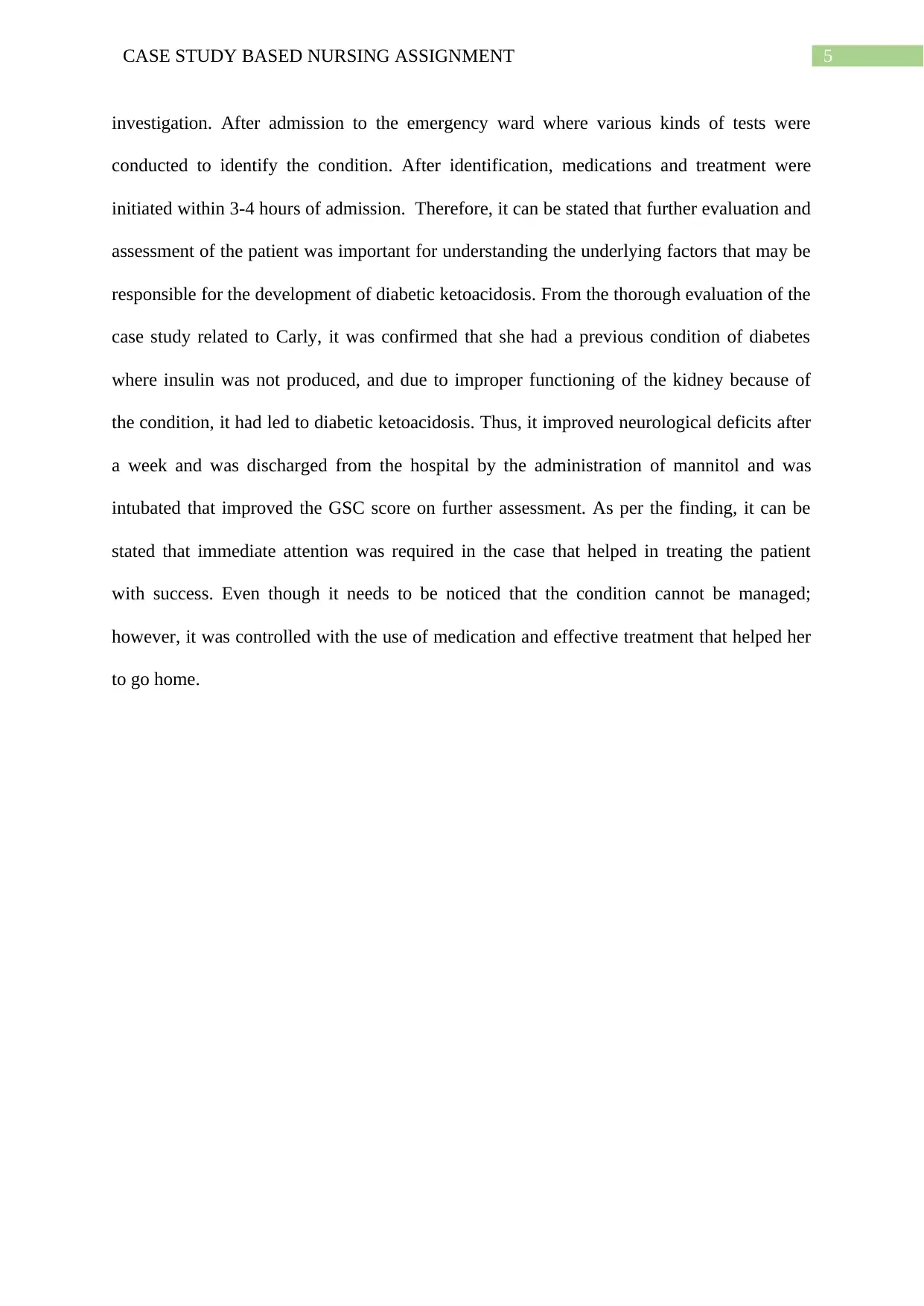
5CASE STUDY BASED NURSING ASSIGNMENT
investigation. After admission to the emergency ward where various kinds of tests were
conducted to identify the condition. After identification, medications and treatment were
initiated within 3-4 hours of admission. Therefore, it can be stated that further evaluation and
assessment of the patient was important for understanding the underlying factors that may be
responsible for the development of diabetic ketoacidosis. From the thorough evaluation of the
case study related to Carly, it was confirmed that she had a previous condition of diabetes
where insulin was not produced, and due to improper functioning of the kidney because of
the condition, it had led to diabetic ketoacidosis. Thus, it improved neurological deficits after
a week and was discharged from the hospital by the administration of mannitol and was
intubated that improved the GSC score on further assessment. As per the finding, it can be
stated that immediate attention was required in the case that helped in treating the patient
with success. Even though it needs to be noticed that the condition cannot be managed;
however, it was controlled with the use of medication and effective treatment that helped her
to go home.
investigation. After admission to the emergency ward where various kinds of tests were
conducted to identify the condition. After identification, medications and treatment were
initiated within 3-4 hours of admission. Therefore, it can be stated that further evaluation and
assessment of the patient was important for understanding the underlying factors that may be
responsible for the development of diabetic ketoacidosis. From the thorough evaluation of the
case study related to Carly, it was confirmed that she had a previous condition of diabetes
where insulin was not produced, and due to improper functioning of the kidney because of
the condition, it had led to diabetic ketoacidosis. Thus, it improved neurological deficits after
a week and was discharged from the hospital by the administration of mannitol and was
intubated that improved the GSC score on further assessment. As per the finding, it can be
stated that immediate attention was required in the case that helped in treating the patient
with success. Even though it needs to be noticed that the condition cannot be managed;
however, it was controlled with the use of medication and effective treatment that helped her
to go home.
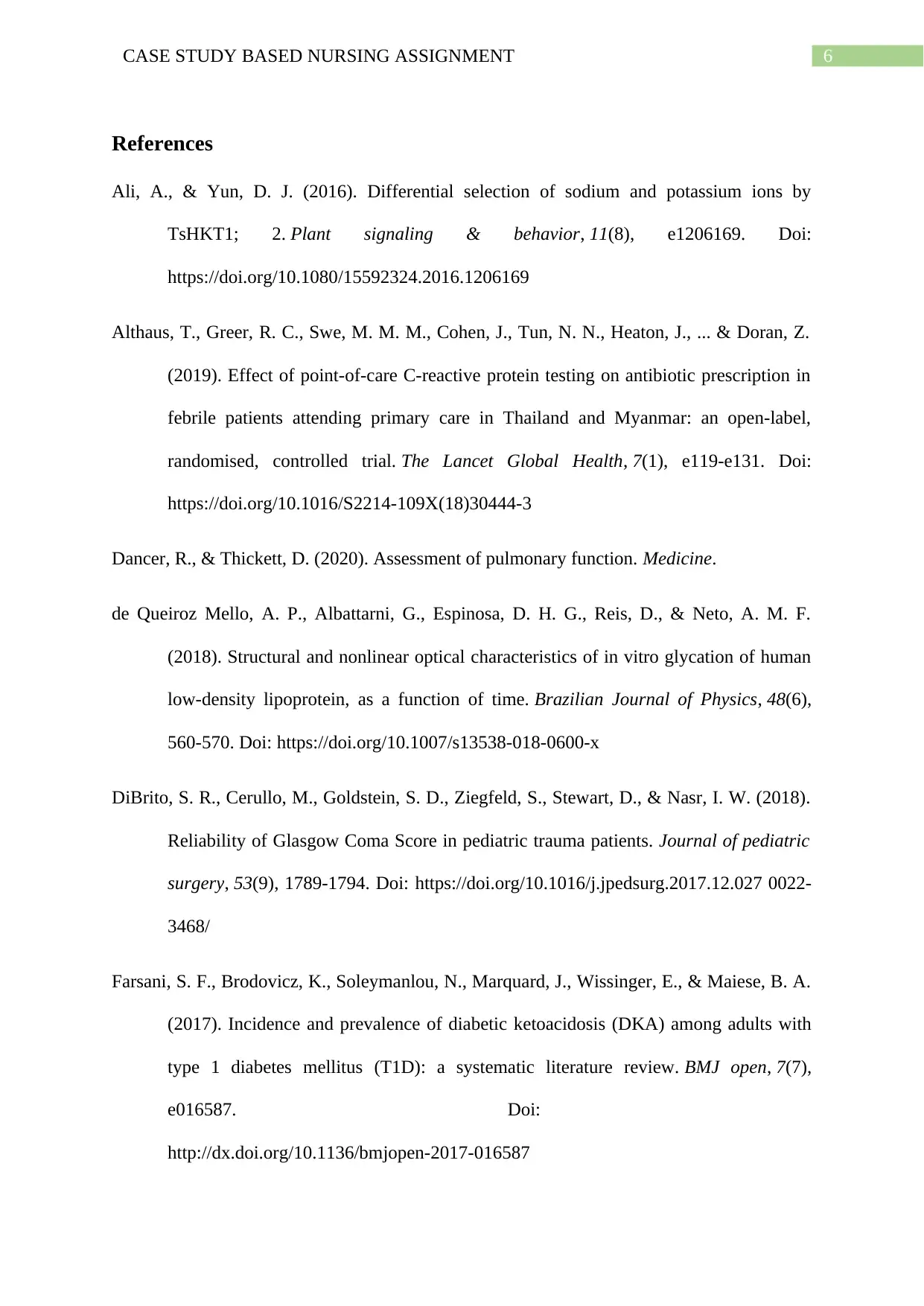
6CASE STUDY BASED NURSING ASSIGNMENT
References
Ali, A., & Yun, D. J. (2016). Differential selection of sodium and potassium ions by
TsHKT1; 2. Plant signaling & behavior, 11(8), e1206169. Doi:
https://doi.org/10.1080/15592324.2016.1206169
Althaus, T., Greer, R. C., Swe, M. M. M., Cohen, J., Tun, N. N., Heaton, J., ... & Doran, Z.
(2019). Effect of point-of-care C-reactive protein testing on antibiotic prescription in
febrile patients attending primary care in Thailand and Myanmar: an open-label,
randomised, controlled trial. The Lancet Global Health, 7(1), e119-e131. Doi:
https://doi.org/10.1016/S2214-109X(18)30444-3
Dancer, R., & Thickett, D. (2020). Assessment of pulmonary function. Medicine.
de Queiroz Mello, A. P., Albattarni, G., Espinosa, D. H. G., Reis, D., & Neto, A. M. F.
(2018). Structural and nonlinear optical characteristics of in vitro glycation of human
low-density lipoprotein, as a function of time. Brazilian Journal of Physics, 48(6),
560-570. Doi: https://doi.org/10.1007/s13538-018-0600-x
DiBrito, S. R., Cerullo, M., Goldstein, S. D., Ziegfeld, S., Stewart, D., & Nasr, I. W. (2018).
Reliability of Glasgow Coma Score in pediatric trauma patients. Journal of pediatric
surgery, 53(9), 1789-1794. Doi: https://doi.org/10.1016/j.jpedsurg.2017.12.027 0022-
3468/
Farsani, S. F., Brodovicz, K., Soleymanlou, N., Marquard, J., Wissinger, E., & Maiese, B. A.
(2017). Incidence and prevalence of diabetic ketoacidosis (DKA) among adults with
type 1 diabetes mellitus (T1D): a systematic literature review. BMJ open, 7(7),
e016587. Doi:
http://dx.doi.org/10.1136/bmjopen-2017-016587
References
Ali, A., & Yun, D. J. (2016). Differential selection of sodium and potassium ions by
TsHKT1; 2. Plant signaling & behavior, 11(8), e1206169. Doi:
https://doi.org/10.1080/15592324.2016.1206169
Althaus, T., Greer, R. C., Swe, M. M. M., Cohen, J., Tun, N. N., Heaton, J., ... & Doran, Z.
(2019). Effect of point-of-care C-reactive protein testing on antibiotic prescription in
febrile patients attending primary care in Thailand and Myanmar: an open-label,
randomised, controlled trial. The Lancet Global Health, 7(1), e119-e131. Doi:
https://doi.org/10.1016/S2214-109X(18)30444-3
Dancer, R., & Thickett, D. (2020). Assessment of pulmonary function. Medicine.
de Queiroz Mello, A. P., Albattarni, G., Espinosa, D. H. G., Reis, D., & Neto, A. M. F.
(2018). Structural and nonlinear optical characteristics of in vitro glycation of human
low-density lipoprotein, as a function of time. Brazilian Journal of Physics, 48(6),
560-570. Doi: https://doi.org/10.1007/s13538-018-0600-x
DiBrito, S. R., Cerullo, M., Goldstein, S. D., Ziegfeld, S., Stewart, D., & Nasr, I. W. (2018).
Reliability of Glasgow Coma Score in pediatric trauma patients. Journal of pediatric
surgery, 53(9), 1789-1794. Doi: https://doi.org/10.1016/j.jpedsurg.2017.12.027 0022-
3468/
Farsani, S. F., Brodovicz, K., Soleymanlou, N., Marquard, J., Wissinger, E., & Maiese, B. A.
(2017). Incidence and prevalence of diabetic ketoacidosis (DKA) among adults with
type 1 diabetes mellitus (T1D): a systematic literature review. BMJ open, 7(7),
e016587. Doi:
http://dx.doi.org/10.1136/bmjopen-2017-016587
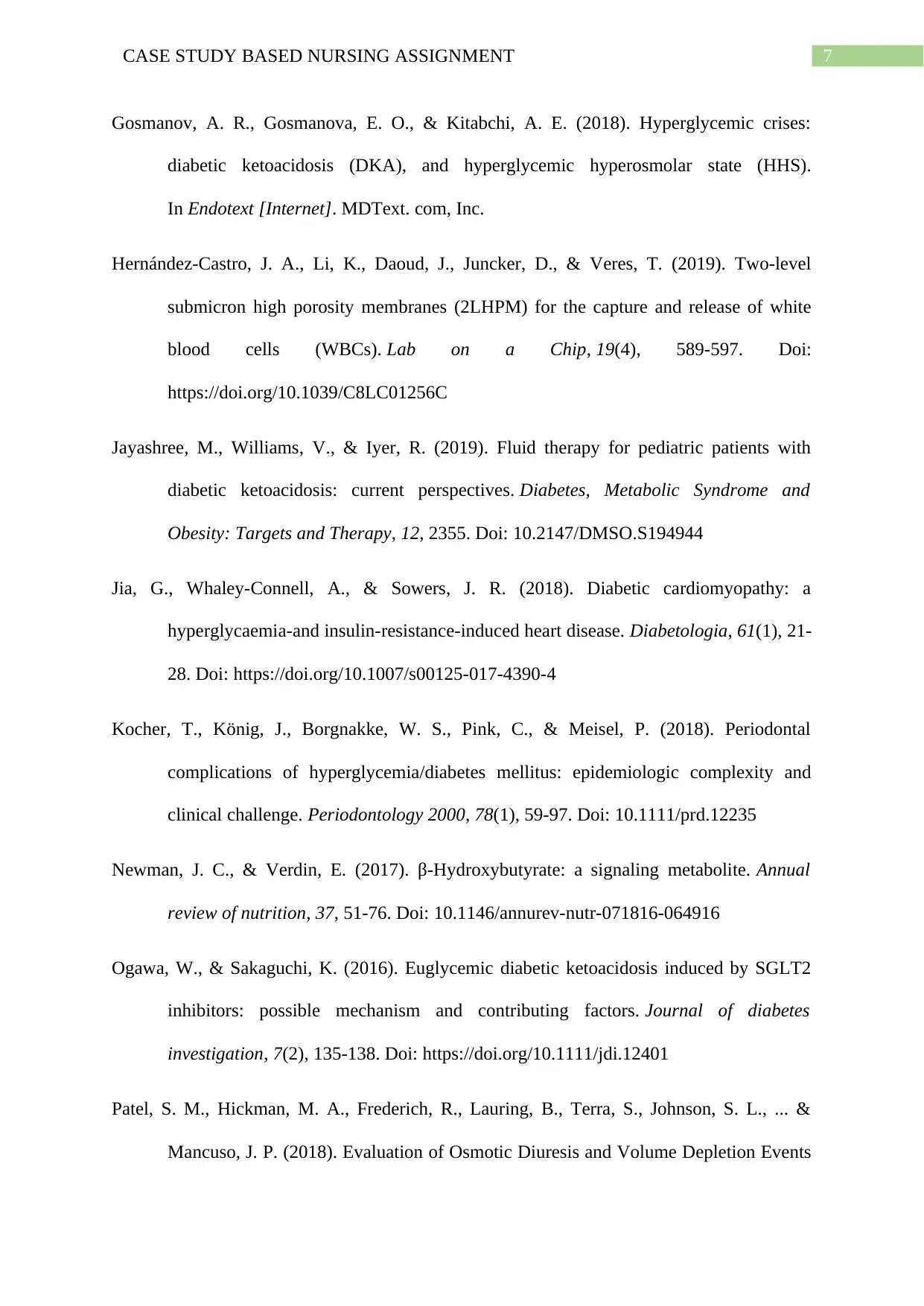
7CASE STUDY BASED NURSING ASSIGNMENT
Gosmanov, A. R., Gosmanova, E. O., & Kitabchi, A. E. (2018). Hyperglycemic crises:
diabetic ketoacidosis (DKA), and hyperglycemic hyperosmolar state (HHS).
In Endotext [Internet]. MDText. com, Inc.
Hernández-Castro, J. A., Li, K., Daoud, J., Juncker, D., & Veres, T. (2019). Two-level
submicron high porosity membranes (2LHPM) for the capture and release of white
blood cells (WBCs). Lab on a Chip, 19(4), 589-597. Doi:
https://doi.org/10.1039/C8LC01256C
Jayashree, M., Williams, V., & Iyer, R. (2019). Fluid therapy for pediatric patients with
diabetic ketoacidosis: current perspectives. Diabetes, Metabolic Syndrome and
Obesity: Targets and Therapy, 12, 2355. Doi: 10.2147/DMSO.S194944
Jia, G., Whaley-Connell, A., & Sowers, J. R. (2018). Diabetic cardiomyopathy: a
hyperglycaemia-and insulin-resistance-induced heart disease. Diabetologia, 61(1), 21-
28. Doi: https://doi.org/10.1007/s00125-017-4390-4
Kocher, T., König, J., Borgnakke, W. S., Pink, C., & Meisel, P. (2018). Periodontal
complications of hyperglycemia/diabetes mellitus: epidemiologic complexity and
clinical challenge. Periodontology 2000, 78(1), 59-97. Doi: 10.1111/prd.12235
Newman, J. C., & Verdin, E. (2017). β-Hydroxybutyrate: a signaling metabolite. Annual
review of nutrition, 37, 51-76. Doi: 10.1146/annurev-nutr-071816-064916
Ogawa, W., & Sakaguchi, K. (2016). Euglycemic diabetic ketoacidosis induced by SGLT2
inhibitors: possible mechanism and contributing factors. Journal of diabetes
investigation, 7(2), 135-138. Doi: https://doi.org/10.1111/jdi.12401
Patel, S. M., Hickman, M. A., Frederich, R., Lauring, B., Terra, S., Johnson, S. L., ... &
Mancuso, J. P. (2018). Evaluation of Osmotic Diuresis and Volume Depletion Events
Gosmanov, A. R., Gosmanova, E. O., & Kitabchi, A. E. (2018). Hyperglycemic crises:
diabetic ketoacidosis (DKA), and hyperglycemic hyperosmolar state (HHS).
In Endotext [Internet]. MDText. com, Inc.
Hernández-Castro, J. A., Li, K., Daoud, J., Juncker, D., & Veres, T. (2019). Two-level
submicron high porosity membranes (2LHPM) for the capture and release of white
blood cells (WBCs). Lab on a Chip, 19(4), 589-597. Doi:
https://doi.org/10.1039/C8LC01256C
Jayashree, M., Williams, V., & Iyer, R. (2019). Fluid therapy for pediatric patients with
diabetic ketoacidosis: current perspectives. Diabetes, Metabolic Syndrome and
Obesity: Targets and Therapy, 12, 2355. Doi: 10.2147/DMSO.S194944
Jia, G., Whaley-Connell, A., & Sowers, J. R. (2018). Diabetic cardiomyopathy: a
hyperglycaemia-and insulin-resistance-induced heart disease. Diabetologia, 61(1), 21-
28. Doi: https://doi.org/10.1007/s00125-017-4390-4
Kocher, T., König, J., Borgnakke, W. S., Pink, C., & Meisel, P. (2018). Periodontal
complications of hyperglycemia/diabetes mellitus: epidemiologic complexity and
clinical challenge. Periodontology 2000, 78(1), 59-97. Doi: 10.1111/prd.12235
Newman, J. C., & Verdin, E. (2017). β-Hydroxybutyrate: a signaling metabolite. Annual
review of nutrition, 37, 51-76. Doi: 10.1146/annurev-nutr-071816-064916
Ogawa, W., & Sakaguchi, K. (2016). Euglycemic diabetic ketoacidosis induced by SGLT2
inhibitors: possible mechanism and contributing factors. Journal of diabetes
investigation, 7(2), 135-138. Doi: https://doi.org/10.1111/jdi.12401
Patel, S. M., Hickman, M. A., Frederich, R., Lauring, B., Terra, S., Johnson, S. L., ... &
Mancuso, J. P. (2018). Evaluation of Osmotic Diuresis and Volume Depletion Events
Secure Best Marks with AI Grader
Need help grading? Try our AI Grader for instant feedback on your assignments.
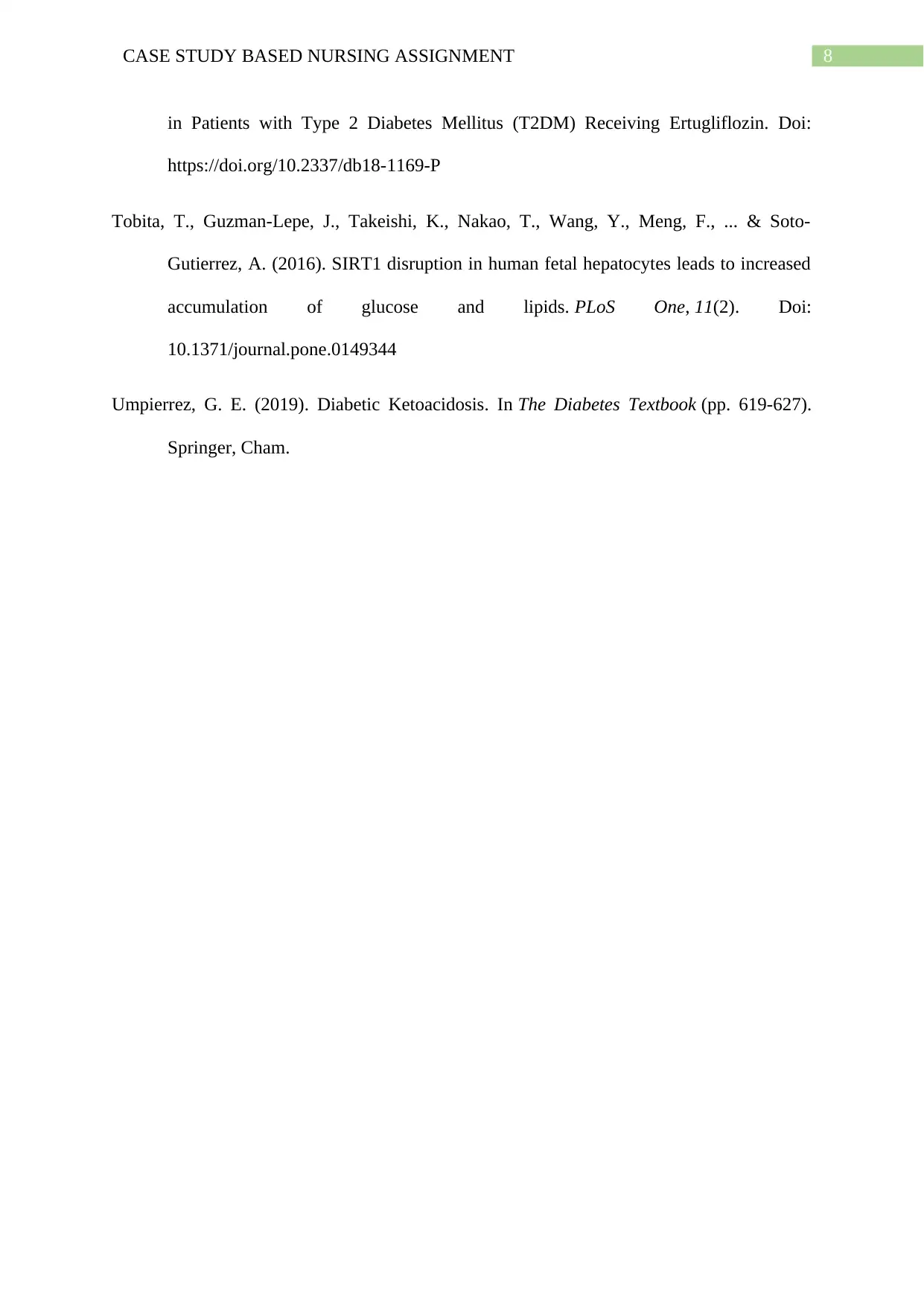
8CASE STUDY BASED NURSING ASSIGNMENT
in Patients with Type 2 Diabetes Mellitus (T2DM) Receiving Ertugliflozin. Doi:
https://doi.org/10.2337/db18-1169-P
Tobita, T., Guzman-Lepe, J., Takeishi, K., Nakao, T., Wang, Y., Meng, F., ... & Soto-
Gutierrez, A. (2016). SIRT1 disruption in human fetal hepatocytes leads to increased
accumulation of glucose and lipids. PLoS One, 11(2). Doi:
10.1371/journal.pone.0149344
Umpierrez, G. E. (2019). Diabetic Ketoacidosis. In The Diabetes Textbook (pp. 619-627).
Springer, Cham.
in Patients with Type 2 Diabetes Mellitus (T2DM) Receiving Ertugliflozin. Doi:
https://doi.org/10.2337/db18-1169-P
Tobita, T., Guzman-Lepe, J., Takeishi, K., Nakao, T., Wang, Y., Meng, F., ... & Soto-
Gutierrez, A. (2016). SIRT1 disruption in human fetal hepatocytes leads to increased
accumulation of glucose and lipids. PLoS One, 11(2). Doi:
10.1371/journal.pone.0149344
Umpierrez, G. E. (2019). Diabetic Ketoacidosis. In The Diabetes Textbook (pp. 619-627).
Springer, Cham.
1 out of 11
Related Documents
Your All-in-One AI-Powered Toolkit for Academic Success.
+13062052269
info@desklib.com
Available 24*7 on WhatsApp / Email
![[object Object]](/_next/static/media/star-bottom.7253800d.svg)
Unlock your academic potential
© 2024 | Zucol Services PVT LTD | All rights reserved.





